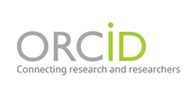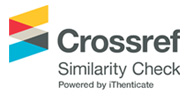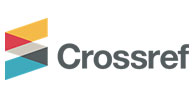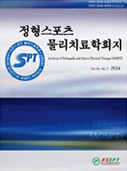Ⅰ. 서 론
목 통증(neck pain)은 전 세계적으로 젊은 성인들 사이 에서 가장 흔한 근골격계 질환 중 하나이며 유병률이 42~67%에 이르는 것으로 보고되고 있다(Algarni et al., 2017). 목 통증이 근골격계 장애 질환 중 발생 빈도가 4번 째로 높다는 사실은 목 통증의 기본적인 원인과 메커니즘 을 이해하고 효과적인 예방 및 치료 전략을 개발하기 위한 연구의 중요성을 강조한다(Maciel et al., 2020).
목뼈는 머리와 목의 정적 및 동적 움직임 조절하는 복 잡한 근육으로 둘러싸여 있다(Versteegh et al., 2020). 목 근육은 머리와 목의 움직임과 안정성을 통해 시각, 청각, 평형의 중요한 감각기관과 통합해야 하는 복잡한 구조이 다(Bexander et al., 2005). 이 통합은 시각, 고유수용성 및 전정기관의 반사가 상호작용하여 조화로운 움직임을 발생시킨다(Badakva et al., 2023). 이러한 반사 중 경안 구반사는 목뼈의 고유수용기에 의해 눈의 움직임을 조절 하여 목 근육을 활성화하고 목의 과도한 회전으로부터 보 호한다(Campbell et al., 2023). 선행연구에서는 목의 회 전 시 시선 방향에 따른 안구의 움직임이 깊은 목 회전 근육의 활성도가 증가한다고 보고하였다(Bexander et al., 2005). 다른 선행연구에서 채찍질 손상 환자는 복잡 한 반사 및 목뼈의 구심성 감각 손상으로 인해 시각 장애 가 발생이 된다고 하였다(Don et al., 2017). 그리고 채찍 질 손상 환자에게 머리를 움직이면서 시선을 고정하기, 눈을 한 방향으로 움직인 후 머리를 움직이기 등 눈과 머 리의 움직임 조절과 시선 안정성을 강조하는 운동이 필요 하다고 제시하고 있다(Treleaven et al., 2011). 이는 눈과 머리 움직임의 조절을 위한 것으로 안구 외안근과 목 근육 간의 상호작용을 통한 안구운동 조절이 중요함을 시사한 다(Bexander & Hodges 2012).
목뼈의 회전은 60% 이상이 위쪽 목뼈에서 발생하며, 목 근육의 약화는 움직임의 제한과 깊은 목 굽힘근의 활성화 장애가 발생하게 된다(Bleton et al., 2023;Pardos- Aguilella et al., 2023). 또한 목 근육의 운동 손상은 근력 감소, 지구력 저하, 목 근육의 활성화 지연 그리고 근 위축 과 같은 구조적 변화를 초래하게 만든다(Edmondston et al., 2011;Schomacher et al., 2012). 체계적인 문헌 고찰 에 따르면 목 통증 환자의 기능을 개선하고 증상을 감소시 키기 위해서 깊은 목 근육의 강화 운동을 포함하는 훈련이 필수적이라고 제시되고 있다(Blomgren et al., 2018). 실 제로 임상에서는 목 통증 감소시키는 중재로 깊은 목 굽힘 근육을 재교육하고 활성화하여 목의 안정성을 증가시키 는 근육으로 중요하게 여기고 있다(Fernandes et al., 2023).
깊은 목 굽힘근 중 하나인 긴목근(Longus Colli)은 목뼈 의 앞굽이와 관절의 안정성을 유지하는 중요한 근육으로 잘 알려져 있다(Ulloa et al., 2020). 특히 긴목근은 다른 표면 근육들과 비교하여 목뼈의 미세한 움직임과 자세를 조절하는 데 핵심적인 기여를 하며, 목의 안정성 및 기능 적 회복과 밀접한 관련이 있다(Bokaee et al., 2021). 선행 연구에 따르면 긴목근 단면적의 감소가 목뼈 퇴행성 척추 전방전위증의 발병률의 증가와 밀접한 연관이 있으며, 이 는 긴목근이 목뼈 안정성을 유지하는 데 있어 핵심적인 역할을 한다는 것을 시사한다(Tran et al., 2022). 이러한 연구결과는 긴목근의 역할을 평가하고 강화하는 것이 목 통증 예방과 재활에 중요한 이유를 보여준다(Mauro et al., 2022).
긴목근의 활성화와 두께 변화를 측정하기 위해 기존 연 구에서는 표면 근전도를 사용하여 깊은 목 굽힘근을 측정 하였지만, 반복적인 측정으로 인해 시간 소모가 많아 임 상적으로 사용하기에는 매우 힘들다고 하였다(Falla et al., 2004). 반면 초음파 장비는 넓은 적용 범위와 근육들 을 실시간으로 명확하게 관찰할 수 있어 긴목근과 같은 심부 근육의 측정에 효과적이다(Javanshir et al., 2024). 긴목근은 초음파 장비를 사용하여 목뼈 6번에서 안정적으 로 측정할 수 있으며(Rombach & Stubbs, 2014), 평가자 내 신뢰도는 ICC 0.90(95% CI: 0.83-0.95)으로 매우 높은 신뢰도를 보였다(O’Riordan et al., 2016). 또한 최근 연구 에서는 만성 목 통증 환자에게 목 굽힘 운동 시 안구운동 방향에 따라 긴목근의 근육 두께에 차이가 나타나는 것으 로 보고되었다(Lee & Seo, 2020).
그러나 목 회전 움직임 중 시선에 따른 안구운동 조절 이 긴목근의 근육 두께 변화에 대한 연구는 아직 부족한 실정이다. 따라서 본 연구의 목적은 초음파를 이용하여 목 회전 움직임 동안 시선 조절에 따른 안구운동이 긴목근 의 두께에 미치는 영향을 분석하는 것이다. 이를 통해 목 회전 시 시각적 입력과 목 근육의 상호작용을 이해하고, 시선 조절을 활용한 새로운 재활 운동 프로그램 개발의 기초 자료를 제공하고자 한다.
Ⅱ. 연구 방법
1. 연구 대상자
부산광역시 D 대학교에 재학 중인 건강한 성인 13명을 대상으로, 본 연구의 목적을 충분히 이해하고 자발적으로 연구에 참여하기로 동의한 자로 선정하였다. 본 연구는 헬싱키 선언(Declaration of Helsinki)의 윤리적 원칙에 기반하여 수행되었으며, 연구자들은 생명윤리와 연구 윤 리 관련 교육을 사전에 이수하였다. 대상자 선정 기준은 최근 3개월간 목 통증이 없는 자, 교정시력 0.5 이상인 자, 청각 25dB 이하의 청력 기준을 충족하는 건강한 성인 으로 설정하였다(Parada et al., 2021). 제외 기준은 최근 두통, 전정 장애, 천식, 시각 장애, 머리나 목에 대한 심각 한 외상 경험, 상지 근골격계 병력이 있는 경우 연구에서 제외되었다.
2. 측정도구 및 실험도구
1) 긴목근 두께
긴목근을 측정하기 위해 초음파 영상장비(Vscan Air, GE Healthcare, Chicago, USA)를 사용하였으며, 7.5MHz 선형 변환기와 50Hz 벽 필터 설정으로 측정하였다(Figure 1). 긴목근의 두께 측정은 임상경력 10년 이상의 숙련된 물리치료사에 의해 시행되었다. 수집된 초음파 영상은 영 상분석시스템(ImageJ, NIH, version 1.47)을 이용하여 처 리되었고, 이를 통해 긴목근의 근육 두께를 측정하였다. 긴목근의 측정은 갑상선 연골의 상부를 촉진하고, 이 높이 보다 2cm 아래에 표시한 후 C5-C6 수준에서 영상을 촬영 하였다. 그리고 목의 수직 축에 수직으로 변환기를 배치하 고 긴목근의 축 단면 이미지를 3회 기록하고 평균값을 산 출하였다(Thongton et al., 2022)(Figure 2).
Figure 2
Ultrasonography image of the Longus Colli (A: Horizontal TR, B: Vertical TR, LC: Longus Colli, TR: Thickness Ratio)

긴목근의 수축율을 비교하기 위해 휴식 시 긴목근 두께 와 각 조건의 긴목근 값을 넣어 아래와 같은 수식을 이용 하여 표준화하였다.
3. 실험절차
모든 대상자는 목뼈를 단독적으로 수평 회전하기 위해 바로 앉은 상태에서 레이저 빔이 이마 중앙에 위치하도 록 레이저 피드백 장비(SenMoCOR™ laser headlamp, Orthopedic Physical Therapy Products, USA)를 착용하 였다. 표적은 1.5M 떨어진 눈높이에 설치하고 고니오미 터를 사용하여 45°의 회전 각도를 표적에 표시하였다 (GyroCoach, Stimson Biokinematics, USA). 다음으로 모든 대상자는 수평으로 45°로 회전하도록 지시하였으며 회전하는 동안 다음 세 가지 조건을 동시에 수행하였다. 첫째, 시선을 정면의 표적에 고정하면서 회전하기 둘째, 시선을 레이저 빔을 주시하면서 머리와 함께 회전하기 셋 째, 시각 정보를 차단한 상태에서 회전하도록 한 후 긴목 근의 두께를 측정하였다(Figure 3).
4. 자료분석
측정된 자료는 SPSS 26.0(IBM Corp, USA) for windows 프로그램을 이용하여 분석하였다. 안구운동 시선 방향에 따른 긴목근의 두께를 분석하기 위해 일원배치 분산분석 (one-way ANOVA)으로 분석되었으며, 사후검정은 본페 로니 수정(Bonferroni correction)을 이용하였다. 통계학 적 유의수준(α)은 .05로 설정하였다. 연구 대상자에 대한 일반적 특성은 기술통계를 이용하여 분석하였다.
Ⅲ. 연구 결과
1. 대상자의 일반적 특성
본 연구 참여한 대상자들의 일반적 특성은 남성 7명 53.8(%), 여성 6명 46.2(%)으로 평균 나이 22.00±2.760, 키 167.07±10.49cm, 몸무게 61.92±16.29kg이었다 (Table 1).
Table 1
Characteristics of subjects (N=13)
| Variable | Mean±SD |
|---|---|
|
|
|
| Age (years) | 22.00±1.15 |
| Height (cm) | 167.07±10.49 |
| Weight (kg) | 51.6±2.4 |
| Body weight (kg) | 61.92±16.29 |
| Gender(male/female) | 7/6(53.8%/46.2%) |
2. 안구운동에 따른 긴목근 두께 분석
목 회전 움직임 중 안구운동 조절이 긴목근의 수평 수축율을 분석한 결과 시선을 정면으로 고정하는 조건 에서 다른 두 가지 조건과 유의한 차이가 있었다(p<.05) (Table 2).
Table 2
Changes in the thickness of the cervical deep flexor muscles according to the direction of gaze (N=13)
| EFT | EWH | EC | F | p | |
|---|---|---|---|---|---|
|
|
|||||
| HTR | 1.29±.17a | 1.08±.12b | .96±.11b | 18.111 | 0.000 |
| VTR | 1.40±.37 | 1.23±.30 | 1.09±.36 | 2.538 | .0930 |
| Area | .55±.144a | .40±.07b | .31±.07b | 17.067 | 0.000 |
*p<05, Mean±SD, Different letters (a,b) indicate statistical significance (p<.05). EFT: Eyes fixed front, EWH: Eyes with Head, EC: Eyes closed, HTR: Horizontal thickness ratio, VTR: Vertical thickness ratio.
긴목근의 수직 수축율은 모든 조건에서 유의한 차이가 없었다(p>.05)(Table 2).
긴목근의 면적에서는 시선을 정면으로 고정하면서 회 전하는 조건이 다른 두 가지 조건과 유의한 차이가 있었다 (p<.05)(Table 2).
Ⅳ. 고 찰
본 연구는 건강한 성인을 대상으로 목을 회전하는 동안 시선에 따른 안구운동 조절이 긴목근에 미치는 영향을 알 아보고자 하였다.
긴목근은 목뼈의 전면 심부에 위치하며, 목의 안정성 과 움직임의 정밀한 조절을 담당하는 주요 근육이다 (Javanshir et al., 2024). 위, 중간, 아래로 나뉘는 세 가 지 섬유를 통해 목뼈와 등뼈의 다양한 부위에 부착되어 목뼈를 지지하고 안정화한다(Zibis et al., 2013;Kennedy et al., 2017). 그러나 긴목근은 심부 근육으로 촉진 (Palpation)과 같은 전통적인 평가 방법으로 정확히 확인 하기 어렵기 때문에 초음파를 활용한 객관적인 측정이 필 요하다(Mohseni et al., 2024). 초음파는 근육의 두께 변 화를 측정하는 데 신뢰성이 높은 도구로, 근육의 위축 및 활성화를 평가하는 데 적합하다(Øverås et al., 2017;Javanshir et al., 2010).
연구 결과 시선을 정면으로 유지하는 조건에서 긴목근 의 수평 수축률과 면적에서 유의한 차이가 있었으며, 이 는 긴목근이 목뼈 안정화와 움직임 조절에 중요한 역할을 한다는 것을 확인할 수 있었다. 특히 목 회전 시 시선 고정 이 심부 목 근육의 선택적 활성화를 유도한다는 기존 연구 결과(Bexander et al., 2005)와 일치하며, 본 연구에서는 이러한 변화가 긴목근의 수평 단면적 두께와 면적 증가로 나타났음을 확인하였다.
선행연구에서는 목 굽힘 시 긴목근의 수직 단면적 두께 증가를 주요 활성화 지표로 평가하였으나(Lee & Seo, 2020), 본 연구에서는 목 회전 시 수직 단면적 변화가 유 의하지 않았으며 반면에 수평 단면적에서 유의한 차이가 있었다. 이러한 결과는 선행연구의 결과와 상반된 결과를 보여 결과분석을 보완하기 위해 타원형 면적 계산식을 적 용하여 긴목근의 단면적 변화를 정량적으로 분석하였다. 이를 통해 시선을 정면으로 유지하는 조건이 머리와 함께 회전하거나 시각을 차단한 조건보다 긴목근의 더 큰 단면 적 변화를 유도한다는 점을 확인하였다.
긴목근의 활성화는 단순히 목뼈 안정화와 움직임 조절 에 기계적으로 기여하는 것뿐만 아니라, 고유수용성 감각 을 통해 신경학적 피드백 메커니즘을 강화하기 위해 중요 한 역할을 한다고 알려져 있다(Malmström et al., 2017). 본 연구는 목 회전 운동과 시선 고정이라는 조건에서 긴목 근의 역할을 추가적으로 확인하였으며, 이는 선행연구에 서 밝혀진 긴목근의 섬유 방향성과 해부학적 구조가 고유 수용성 감각과 안정성에 기여한다는 것과 일치하는 결과 를 보였다(Kennedy et al., 2017). 이러한 결과는 긴목근 이 단순히 안정화 구조에 그치지 않고, 머리와 목의 정밀 한 움직임 조절과 신경학적 피드백 과정에서도 핵심적으 로 작용한다는 것을 시사한다.
또한 긴목근의 활성화는 전정안구반사와 밀접하게 연 결되어 있으며 시각 및 전정 신호를 통합하여 시야를 안정화하고 목 근육의 움직임을 조절한다(Schubert & Migliaccio, 2019). 전정안구반사는 머리의 위치 변화 시 고유수용성 감각과 상호작용하여 적절한 근육 반응을 유 도함으로써 시야 안정화를 넘어 전신 자세와 균형 조절에 도 영향을 미친다(Johnston et al. 2017). 이러한 과정은 목뼈의 안정성을 유지하는 동시에 회전 움직임의 정밀성 을 강화함으로써 긴목근의 역할을 명확히 보여준다. 특히 긴목근은 목뼈의 미세한 흔들림을 제어하는 피드백 루프 에서 핵심적인 역할을 한다(Happee et al., 2017). 고유수 용기와 근방추에서 생성된 감각 정보는 중추신경계를 통 해 빠르게 처리되며, 자세와 움직임 조절을 위한 근육 반 응을 조절한다(Takakusaki et al., 2016). 이러한 과정은 목뼈의 안정성을 유지하고 움직임의 정밀성을 강화하기 위한 피드백 루프의 핵심 요소로 작용하며, 긴목근이 목 뼈의 안정성과 움직임 조절에 다기능적으로 기여한다는 것을 뒷받침한다.
결론적으로 긴목근은 고유수용성 감각 입력과 신경학 적 메커니즘을 통해 목뼈 안정성과 회전 움직임을 조절하 기 위해 핵심적인 역할을 한다. 이 과정은 전정안구반사 뿐만 아니라 자세 조절과 근육 피드백 메커니즘을 포함한 복합적인 신경학적 상호작용을 기반으로 하며, 긴목근을 중심으로 한 재활 및 운동 치료 전략이 효과적일 수 있음 을 시사한다.
본 연구의 결과를 종합해 보면 시선을 정면으로 유지하 면서 목을 회전하는 안구운동이 시선과 머리를 함께 회전 하는 조건과 시각을 차단하고 회전하는 조건에 비해 긴목 근의 수축두께를 증가시킴을 확인할 수 있었다. 이러한 결과는 긴목근이 목의 굽힘뿐만 아니라 회전 운동에도 관 여하며 목뼈의 안정성과 회전 움직임 조절에 중요한 역할 을 담당하는 것을 보여준다. 이를 통해 긴목근이 목의 다 방향 움직임에서 중요한 역할을 하는 근육임을 확인할 수 있었다. 따라서 임상 현장에서는 시선 조절을 포함한 안 구운동이 긴목근의 수축을 강화하는 효과적인 목 안정화 운동 방법으로 활용될 수 있을 것이다.
본 연구의 제한점으로 첫째, 건강한 성인을 적은 표본 으로 연구를 진행하였기 때문에 목 통증을 호소하는 환자 들에게 일반화하기에는 한계가 있다. 둘째, 중재 기간 없 이 얻은 결과를 바탕으로 즉각적인 효과를 평가하였지만, 장기적인 효과를 해석하기에는 어려움이 있다. 따라서 향 후 연구에서는 참여 대상자 수를 확대하고, 목 통증 환자 를 대상으로 중재 기간을 도입하여 안구운동의 장기적인 효과에 대한 연구가 필요할 것이다.
Ⅴ. 결 론
본 연구는 건강한 성인을 대상으로 시선에 따른 안구운 동 조절이 긴목근의 두께에 미치는 영향을 알아보고자 하 였다. 안구운동 조절을 정면으로 유지하면서 목을 회전하 는 것이 긴목근의 수축두께가 가장 유의하게 증가하는 것 을 확인하였다. 이러한 결과는 정면으로 시선을 유지하면 서 목을 회전하는 것이 긴목근의 두께가 가장 효과적으로 수축할 수 있는 방법임을 확인하였다.


















